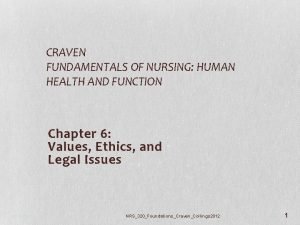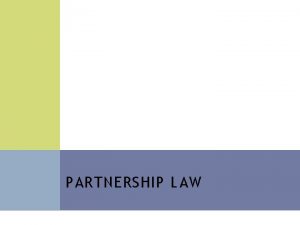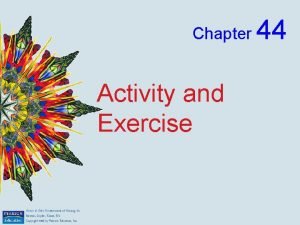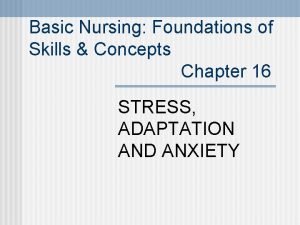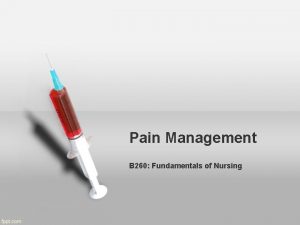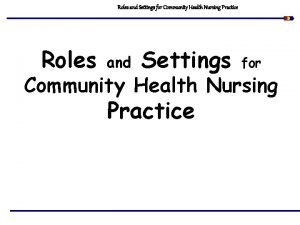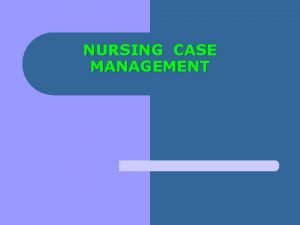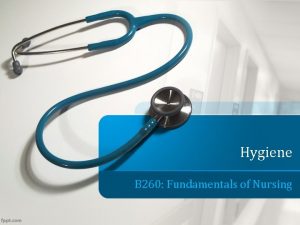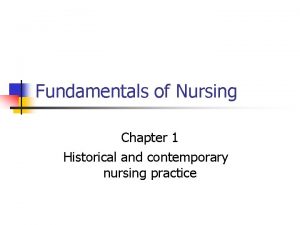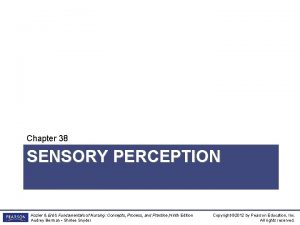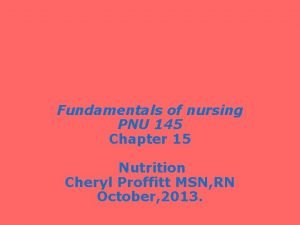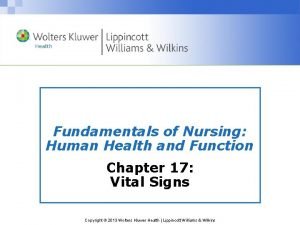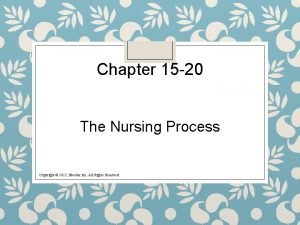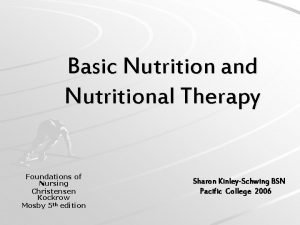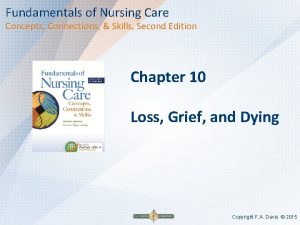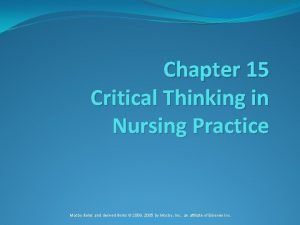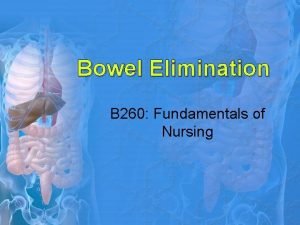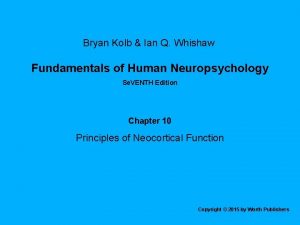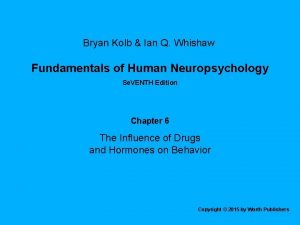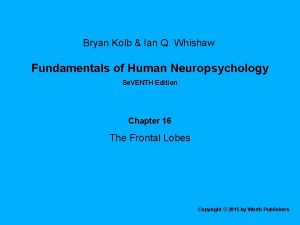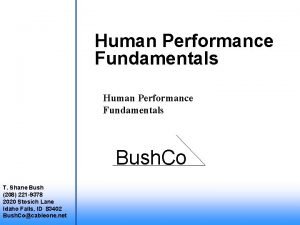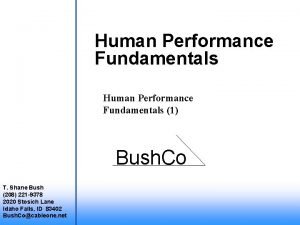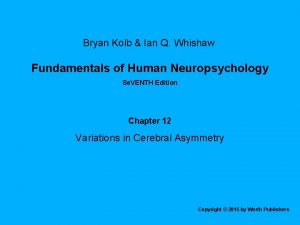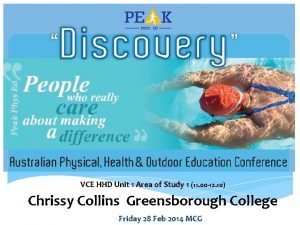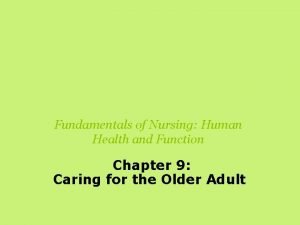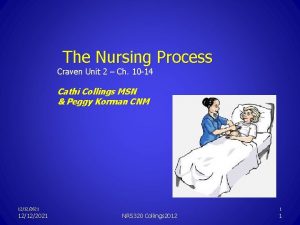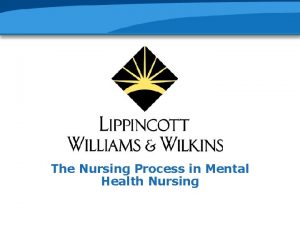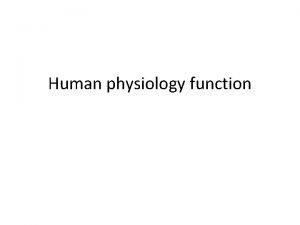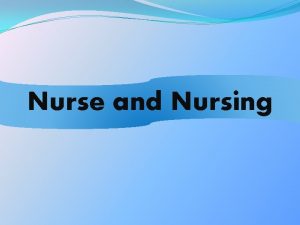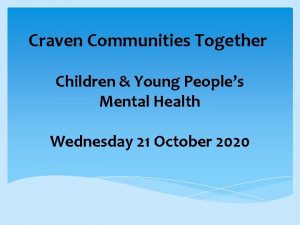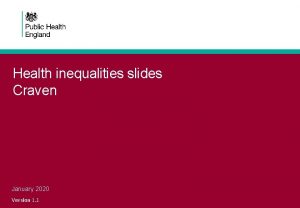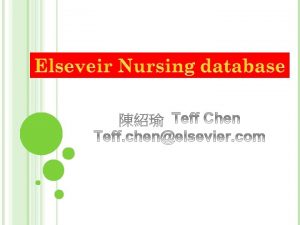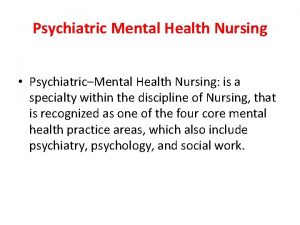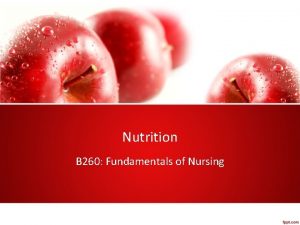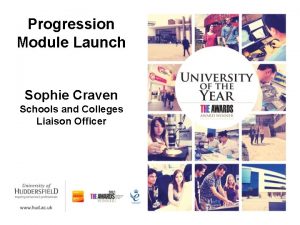Craven Fundamentals of Nursing Human Health and Function
































- Slides: 32

Craven Fundamentals of Nursing: Human Health and Function Chapter 8: Patient Education and Health Promotion NRS_320_Craven Collings 2012 1

Teaching–Learning Process �Learning: The acquisition of a skill or knowledge by practice, study, or instruction �Different conceptual models of the learning process view the teacher’s role as director, designer, programmer, or producer NRS_320_Craven Collings 2012 2

Teaching–Learning Process (Cont’d) �Examples ◦ Learning anatomy: Need to memorize facts ◦ Dealing with patients: Intuitive component ◦ Pharmacology: Previous knowledge of pathophysiology, chemistry, anatomy, physiology, and mathematics NRS_320_Craven Collings 2012 3

Teaching–Learning Process (Cont’d) �Domains of learning ◦ Cognitive: Refers to rational thought, what one generally considers “thinking” �May involve learning facts, reaching conclusions, solving problems, making decisions, or using critical thinking skills ◦ Example: Teaching a new mother the physiology of the breast and its role in milk production NRS_320_Craven Collings 2012 4

Teaching–Learning Process (Cont’d) �Affective: ◦ Emotions or feelings ◦ Changes beliefs, attitudes, or values �Example: Helping a new mother explore the possible benefits of breast-feeding for the health of her baby NRS_320_Craven Collings 2012 5

Question true or false: Affective learning changes beliefs, attitudes, or values. NRS_320_Craven Collings 2012 6

Answer True. Rationale: Affective learning changes beliefs, attitudes, or values. NRS_320_Craven Collings 2012 7

Teaching–Learning Process (Cont’d) �Psychomotor ◦ Muscular movements learned to perform new skills and procedures ◦ Important: Dexterity to manipulate the body parts, tools, or objects needed to perform the skill or procedure NRS_320_Craven Collings 2012 8

Teaching–Learning Process (Cont’d) �Teaching–learning relationship ◦ Characterized by mutual sharing, advocacy, and negotiation �Effective learning ◦ Occurs when patients and healthcare professionals are equal participants in the teaching–learning process NRS_320_Craven Collings 2012 9

Teaching–Learning Process (Cont’d) �Qualities of a teaching–learning relationship ◦ Patient focus ◦ Holism ◦ Negotiation ◦ Interactive NRS_320_Craven Collings 2012 10

Purposes of Patient Education �To promote Health/wellness �(primary prevention) • Prevent or diagnose illness early • (secondary prevention) �Restore optimal health and function if illness has occurred �(tertiary prevention) �Assist patients and families to cope with alterations in health status NRS_320_Craven Collings 2012 11

Purposes of Patient Education (Cont’d) �Health promotion �Disease prevention �Restoration of health or function �Promotion of coping NRS_320_Craven Collings 2012 12

Assessment for Learning �Assessing learning needs: Begins with determining what the patient needs to know or do to function more independently ◦ Baseline knowledge ◦ Cultural and language needs ◦ Priorities NRS_320_Craven Collings 2012 13

Assessment for Learning (Cont’d) �Realistic ◦ ◦ approach Patient’s energy/comfort level Patient’s age Patient’s emotional state Patient’s cognitive abilities NRS_320_Craven Collings 2012 14

Assessment for Learning (Cont’d) � Assessing learning readiness ◦ Motivation/ desire to learn ◦ Compliance ◦ Sensory and physical state ◦ Literacy level ◦ Health literacy level NRS_320_Craven Collings 2012 15

Nursing Diagnoses Health-Seeking Behaviors ◦ Active seeking of ways to alter personal habits or the environment to move toward a higher level of health • Ineffective Therapeutic Regime Management (Individual or Family) – Difficulty effectively integrating a treatment program into daily activities to meet health goals • NRS_320_Craven Collings 2012 16

Nursing Diagnoses (Cont’d) � Deficient Knowledge ◦ Absence of cognitive information related to a specific topic NRS_320_Craven Collings 2012 17

Outcome Identification and Planning �Involves working with patients to develop a teaching plan, identifying appropriate teaching strategies, and developing a written plan to coordinate teaching among healthcare team members NRS_320_Craven Collings 2012 18

Outcome Identification and Planning (Cont’d) �Outcome identification: Patientcentered, patient-involved goals are most effective �Planning teaching strategies: Availability of resources, learning style preference, literacy level, and health literacy level affect planning of effective teaching strategies NRS_320_Craven Collings 2012 19

Outcome Identification and Planning (Cont’d) �Planning teaching strategies (cont’d) ◦ Lectures ◦ Discussion ◦ Demonstration ◦ Role-playing NRS_320_Craven Collings 2012 20

Outcome Identification and Planning (Cont’d) � Teaching aids and resources; used to supplement or reinforce face-to-face teaching ◦ Pamphlets ◦ Audiovisual aids ◦ The Internet ◦ Equipment and models NRS_320_Craven Collings 2012 21

Outcome Identification and Planning (Cont’d) �Use of interpreters and translators �Timing and amount of information �Appropriate family and friend involvement �Written teaching plan NRS_320_Craven Collings 2012 22

Implementation of Patient Teaching �Meeting priority needs first �Comfortable environment �Individualized teaching sessions �Communication �Repetition NRS_320_Craven Collings 2012 23

Implementation of Patient Teaching (Cont’d) �Teaching methods ◦ Cognitive ◦ Affective ◦ Psychomotor NRS_320_Craven Collings 2012 24

Evaluation of Learning �Written tests and questionnaires �Oral tests �“Teach-back” �Return demonstration �Check-off lists �Simulation NRS_320_Craven Collings 2012 25

Documentation of Learning �Documenting patient education is as important as documenting any other aspect of patient care NRS_320_Craven Collings 2012 26

Lifespan Considerations �Newborn and infant �Toddler and preschooler �School-age child and adolescent �Adult and older adult NRS_320_Craven Collings 2012 27

Newborn and Infant �Immunizations �Normal growth and development (regular developmental and health checkups) �Car seat safety NRS_320_Craven Collings 2012 28

Toddler and Preschooler �Safety practices �Well-child visits �Proper sleep �Nutrition �Avoidance of secondhand tobacco smoke �Regular immunization schedules NRS_320_Craven Collings 2012 29

School-Age Child �Proper nutrition �Sleep �Exercise �Safety �Learning to deal with stress and frustration NRS_320_Craven Collings 2012 30

Adolescent �Smoking �Safe driving �Preventing sexually transmitted diseases (STDs) �Avoiding drugs and alcohol �Preventing pregnancy �Avoiding gang-related violence �Maintaining mental health NRS_320_Craven Collings 2012 31

Adult and Older Adult �Exercise �Nutrition �Self-examinations �Health screening �Stress management �Reduction or cessation of smoking and alcohol consumption �Prenatal care for women NRS_320_Craven Collings 2012 32
 Fundamentals of nursing craven
Fundamentals of nursing craven Section 2 of partnership act 1961
Section 2 of partnership act 1961 Activity and exercise fundamentals of nursing
Activity and exercise fundamentals of nursing Stress and adaptation fundamentals of nursing
Stress and adaptation fundamentals of nursing Pain definition nursing
Pain definition nursing Definition of community health nurse
Definition of community health nurse Function of community health nursing
Function of community health nursing Chapter 1 health and wellness fundamentals
Chapter 1 health and wellness fundamentals Chapter 1 understanding health and wellness
Chapter 1 understanding health and wellness Hygiene fundamentals of nursing
Hygiene fundamentals of nursing Fundamental of nursing chapter 1
Fundamental of nursing chapter 1 Admission of patient in hospital
Admission of patient in hospital Sensory functioning fundamentals of nursing
Sensory functioning fundamentals of nursing Nutritional needs in fundamentals of nursing
Nutritional needs in fundamentals of nursing Fundamentals of nursing chapter 17 vital signs
Fundamentals of nursing chapter 17 vital signs Fundamentals of nursing chapter 15 critical thinking
Fundamentals of nursing chapter 15 critical thinking Nutrition and diet therapy nursing
Nutrition and diet therapy nursing Elimination needs
Elimination needs Vital signs fundamentals of nursing
Vital signs fundamentals of nursing Fundamentals of nursing care concepts connections & skills
Fundamentals of nursing care concepts connections & skills Kataoka-yahiro and saylor's model
Kataoka-yahiro and saylor's model Dorsal position in nursing
Dorsal position in nursing Bowel elimination fundamentals of nursing
Bowel elimination fundamentals of nursing Human performance modes
Human performance modes Maup kolb
Maup kolb Fundamentals of human neuropsychology
Fundamentals of human neuropsychology Fundamentals of human neuropsychology
Fundamentals of human neuropsychology Human performance fundamentals
Human performance fundamentals Human performance fundamentals
Human performance fundamentals Kolb whishaw fundamentals of human neuropsychology
Kolb whishaw fundamentals of human neuropsychology Staffing and nursing care delivery models
Staffing and nursing care delivery models Hhd study design 2021
Hhd study design 2021 Health and social component 3
Health and social component 3
